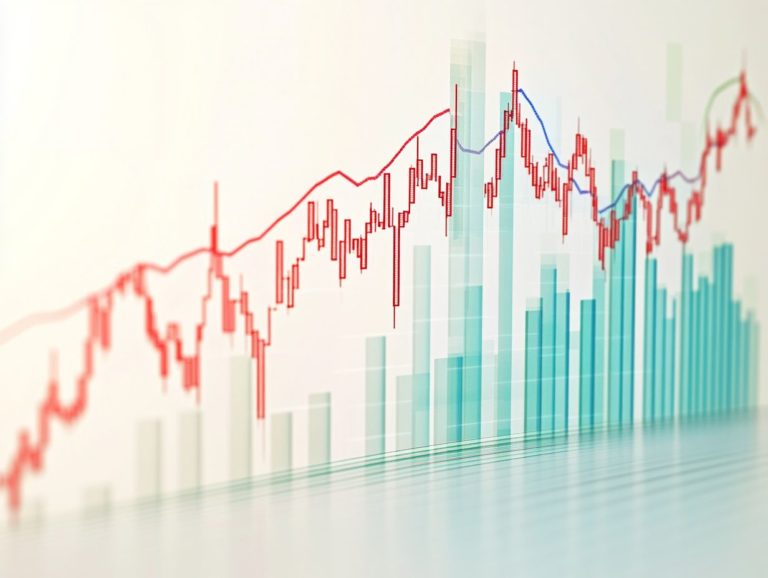What Are the Risks of Leverage in Trading?
Leverage can serve as a formidable tool in your trading arsenal, empowering you to amplify your potential profits.
With great power comes significant risk. This article will define leverage and highlight its advantages.
You ll gain insight into how leverage can maximize your opportunities while also uncovering potential pitfalls that could lead to substantial losses.
Effective strategies for managing leverage will be explored, alongside crucial regulations you should keep in mind.
You must understand leverage to thrive in trading!
Contents
- Key Takeaways:
- Understanding Leverage in Trading
- The Benefits of Leverage
- The Risks of Leverage
- Managing Leverage in Trading
- Regulations and Guidelines for Leverage
- Frequently Asked Questions
- What Are the Risks of Leverage in Trading?
- What is leverage and how does it work?
- What are the main risks of using leverage in trading?
- How does leverage affect risk management?
- What are some ways to mitigate the risks of leverage in trading?
- Can leverage be beneficial for traders?
- What steps should I take before using leverage in my trading?
Key Takeaways:

- Leverage in trading allows for increased potential profits but carries the risk of losses.
- Proper risk management strategies minimize potential losses and maximize opportunities.
- Follow industry regulations and best practices for responsible leverage use.
Understanding Leverage in Trading
Understanding leverage in trading is essential for you as a trader. It involves using borrowed capital to amplify potential returns on your investments in the forex markets. Your profits can soar, but so can your losses.
Leverage enables you to control larger positions with a smaller amount of your own capital. It is a powerful yet precarious tool in the complex world of finance. When applied thoughtfully, leverage can significantly enhance your trading strategies and unveil substantial opportunities.
It s essential for you to grasp margin trading using borrowed money to trade larger amounts than you have and the associated risk factors to steer clear of pitfalls like margin calls.
Definition and Explanation
Leverage in trading is your secret weapon, enabling you to use borrowed capital to amplify the potential returns on your investments. This means you can command a larger trading position in the forex markets with only a fraction of the capital you might expect.
This financial tool comes with its own set of nuances that you must grasp. When you dive into leverage, you typically set aside a margin, which is a percentage of the total position value. For instance, with a leverage ratio of 100:1, every dollar in your account gives you the power to control $100 in the market.
While this can open doors to positions far beyond what your capital alone would allow, it also amplifies your exposure to risk. A slight shift in the market can lead to significant financial repercussions. Understanding and managing that risk is crucial as you navigate the trading landscape.
The Benefits of Leverage
The advantages of leveraging in forex trading are considerable, giving you the power to maximize profits and explore a range of trading opportunities that might otherwise remain out of reach without substantial capital especially in the unpredictable landscape of volatile markets.
With higher leverage, you gain increased exposure to currency fluctuations, which amplifies your profit potential. This comes with its own set of risks, underscoring the importance of having a well-crafted trading strategy to adeptly navigate the complexities of the forex arena.
Maximizing Profits and Opportunities

Maximizing profits in trading demands that you employ effective strategies to leverage favorable currency price movements, enhancing your overall trading performance.
By carefully selecting currency pairs based on prevailing market trends and economic indicators, you position yourself for success in your trades. Timing becomes paramount; pinpointing optimal entry and exit points can dramatically influence your profitability.
Utilizing approaches such as technical analysis, trend following, or scalping can offer significant advantages. You need to implement strong risk management techniques to protect your investments! By incorporating stop orders and stop-loss orders, you create a safety net that helps minimize potential losses while you pursue opportunities for greater returns.
This balanced methodology allows you to take advantage of leverage without falling prey to the inherent risks of market volatility.
The Risks of Leverage
Leverage can boost your potential gains, but it also comes with serious risks. Losses can quickly surpass your initial trading capital.
The inherent volatility of forex markets leads to rapid price fluctuations. Without proper leverage management, you risk margin calls and substantial financial exposure. It’s crucial to maintain a clear understanding of your risk parameters when employing leverage in your trading strategies.
Potential Loss and Exposure
When trading with leverage, consider the potential for losses. If you use 10x leverage on a $1,000 investment, you control $10,000 in assets. A 10% drop means losing your entire investment, highlighting the risks.
Understanding how leverage amplifies both gains and losses is essential as you navigate volatile markets. Employing risk management strategies, such as setting stop-loss orders and utilizing technical analysis techniques like moving averages and the Relative Strength Index (RSI), can help you identify potential downturns.
By analyzing market trends and patterns, you can make informed decisions that minimize exposure. This allows you to protect your funds and sustain a successful trading career.
Managing Leverage in Trading
To safeguard your investments, managing leverage is essential. Set clear risk management strategies that match your risk tolerance and trading abilities.
By implementing measures like stop-loss orders and carefully calculated leverage ratios, you can protect your trading accounts from excessive losses while pursuing profitable opportunities.
Strategies for Risk Management

Effective risk management is vital when using leverage. Evaluate your leverage ratios carefully, as market movements can lead to significant gains or losses. Accurately calculating your margin is crucial to understanding how much capital you re willing to risk on each trade.
By employing stop-loss orders, diversifying your portfolio, and regularly monitoring market conditions, you can effectively balance potential rewards against your exposure to risk. This thoughtful decision-making enhances your profitability and safeguards your investments over the long term, paving the way for sustainable trading success.
Regulations and Guidelines for Leverage
Regulations on leverage help maintain market integrity and protect traders from excessive risks. Following these guidelines leads to a safer trading experience across various financial instruments.
Industry Standards and Best Practices
Understanding industry standards is key for traders. These guidelines help reduce risks in forex trading and support informed decision-making. By following these principles, you can make informed decisions that minimize potential losses while maximizing profit opportunities.
Regularly evaluating market conditions and committing to ongoing education in financial strategies can significantly enhance your ability to navigate the complexities of currency trading. Adopting these practices fosters a disciplined approach that contributes to sustainable success and financial growth in the ever-evolving forex landscape.
Frequently Asked Questions
What Are the Risks of Leverage in Trading?

Leverage is the practice of using borrowed money to increase potential returns on investments. While it can boost profits, it also carries significant risks. Let’s dive into some crucial questions about leverage risks that every trader should know!
What is leverage and how does it work?
Leverage allows traders to control a larger position with a smaller amount of money. For instance, with 10:1 leverage, a trader can manage a $10,000 position with just $1,000. This means both gains and losses are multiplied by 10.
What are the main risks of using leverage in trading?
The main risks of leverage include increased volatility and the potential for significant losses. It also requires a larger margin of safety. With leverage, emotional trading can occur, as larger gains or losses may lead traders to make impulsive decisions.
How does leverage affect risk management?
Leverage can complicate risk management. It can amplify losses and result in margin calls, which require traders to deposit more money into their accounts to cover potential losses.
What are some ways to mitigate the risks of leverage in trading?
Traders can use several strategies to reduce the risks of leverage. These include setting strict risk management rules and diversifying their portfolios. It’s also wise to avoid excessive leverage ratios.
Can leverage be beneficial for traders?
Although leverage carries risks, it can also present opportunities for traders to maximize profits. It is crucial for traders to understand these risks and use leverage wisely to prevent substantial losses.
What steps should I take before using leverage in my trading?
Before using leverage, traders should educate themselves about its risks and potential benefits. They should have a solid grasp of their risk tolerance and establish a clear risk management plan. Starting with a smaller leverage ratio can also be helpful until they gain more experience and confidence in their trading abilities.






